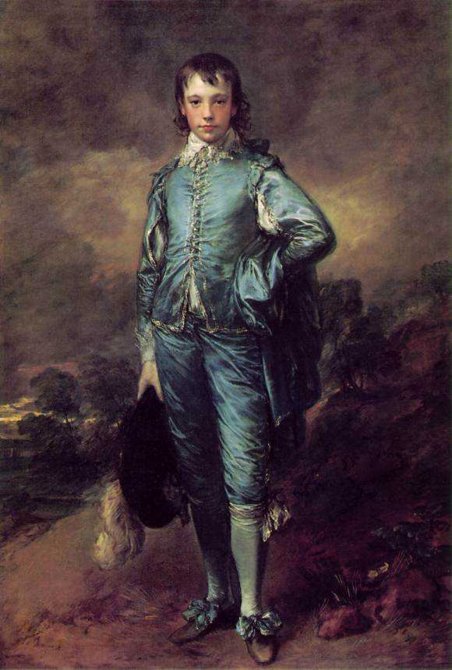Thomas Gainsborough was a celebrated and sought-after portrait painter born in 1727 in Sudbury, England. As a boy, he was inspired to draw the countryside near his home, and throughout his life he also painted landscapes. Gainsborough began his professional career by studying in London with a French engraver named Gravelot, and eventually he became affiliated with William Hogarth, a famous English engraver.
Gainsborough’s well-known portraits include “The Blue Boy” and “The Morning Walk.” His treatment of the clothing on both of these illustrate why critics continue to point to the work of Dutch painter van Dyck as influential to Gainsborough’s style. Viewers note the superb ephemeral quality of the ruffled, gauzy fabrics on the couple in “The Morning Walk” as well as the lacy collar and shimmery velvet-like appearance of the boy’s blue suit. The backgrounds of these two paintings are similar in that they are set outdoors and include loosely rendered trees, but the tone is very different. The couple’s walk (and indeed their life together) seems idyllic because of the blue sky, the doting and friendly dog, and the shelter provided by the tree. The young boy, however, seems dashing and heroic in the foreground of a somewhat darker and more troubled sky. Viewers have the impression that he is emerging from something sublime because in the distance, there is just a great beyond.
Another part of Gainsborough’s career that is of interest is that he helped decorate the supper boxes at Vauxhall Gardens, which was a center of emerging culture during his time. Googling Gainsborough images allows one to see that he clearly contributed to that culture, as he created numerous lovely portraits of middle class and aristocratic people. The variety of backgrounds, from Greek ruins to oil paintings, as well as the array of fashionable clothing, has helped preserve aspects of cultural history that are invaluable. Gainsborough passed away in 1788 after an illustrious career in oil painting that earned him a place as one of the founders of the Royal Society of Arts. His ability to flatter subjects with strokes of his oil paint brushes is the best explanation for his status and fame.
Author: Julie Ann
